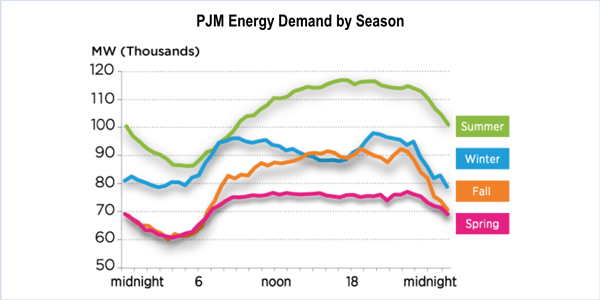By Rory D. Sweeney
In a potential win for PJM ratepayers and demand response providers, FERC on Friday ordered a technical conference to consider whether the RTO should move from a year-round to a seasonal capacity construct (EL17-32, EL17-36).
The commission ordered the conference in response to two complaints: one from the Advanced Energy Management Alliance, and a combined filing from Old Dominion Electric Cooperative, Direct Energy and American Municipal Power.
The order calls for the conference to address whether:
- the exclusive use of a year-round capacity product raises customer costs unnecessarily compared to retention of a seasonal capacity product;
- standalone participation by seasonal resources in non-summer months would jeopardize reliability;
- alternative models, such as establishing distinct summer and winter capacity markets, could assure reliability at lower costs;
- if it is true that nearly all loss-of-load-expectation (LOLE) risk currently exists in 10 summer weeks, there is an alternative distribution of LOLE risk that could meet the one-day-in-10-years reliability target at a lower total cost; and
- PJM’s load forecast methodology incorporates load-serving entities’ peak-shaving actions in an adequate and timely manner to yield just and reasonable rates for consumers.
The order indicates that FERC is having second thoughts about PJM’s year-round Capacity Performance construct — even before the rules have been fully implemented.
PJM proposed CP, which eliminated summer-only DR, to address generator outages that peaked at 22% during the January 2014 polar vortex. The rules call on all resources to be able to respond to dispatch calls throughout the year and requires the RTO to contract for enough year-round capacity to meet its annual demand peaks in the summer. The rules also subject resources to stiff financial penalties if they fail to perform during critical periods known as “performance assessment” intervals. But much of the capacity goes unused in the periods of lower demand: Summer peaks can top 150 GW, while the winter typically peaks at less than 100 GW.
Under PJM’s transition, “base capacity” resources that operate only in certain seasons, such as renewables and DR were phased out. Only CP resources were permitted in last year’s Base Residual Auction, which procured capacity for the 2020/21 delivery year.
The two complaints offered different justifications, but both asked FERC to delay full implementation of CP and continue to allow base capacity resources until rules are developed to allow meaningful participation from seasonal resources. The Pennsylvania Public Utility Commission filed comments in support of their arguments.
AEMA pointed out recent analysis from PJM that showed that the RTO could increase its summer requirements by roughly 500 MW to allow more than 17,000 MW of annual capacity to be replaced by less expensive summer-only resources, and that an additional unit of summer-only capacity has 97% of the reliability value of an additional unit of year-round capacity.
“Once base capacity resources are eliminated, customers will need to pay for tens of thousands of megawatts of unnecessary capacity in non-summer weeks to compensate for the loss of base capacity resources during the peak summer period,” the commission wrote, summarizing AEMA’s argument.
PJM and several generators opposed the complaints, arguing they don’t bring up anything new and aren’t justified. They said the RTO had provided an ample opportunity for participation by seasonal resources. In a separate order last week, FERC approved Tariff revisions that allow offsetting seasonal resources to aggregate into a single, annual product that conforms with CP’s requirements. (See related story, FERC Endorses Previously OK’d PJM Aggregation Rules.)
FERC sided with the complainants.
“Capacity Performance has now been in effect for two years, and the complainants have raised important issues as to whether certain aspects of the construct are performing as well as expected,” the order said. “Complainants present analyses prepared by PJM which call into question the assumption that permitting any standalone participation by seasonal resources would negatively impact reliability in non-summer months.”
FERC Chairman Kevin McIntyre and Commissioner Robert Powelson, former chairman of the Pennsylvania PUC, did not participate in the order. Of the three other commissioners, only Cheryl LaFleur was on the panel when it approved CP in 2015.


